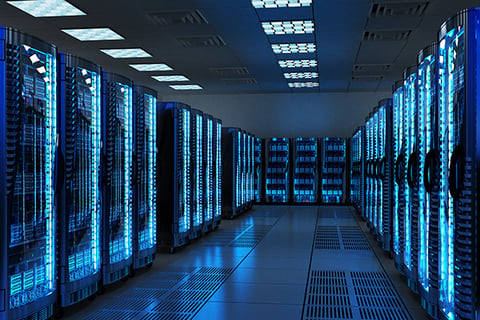
Traditionally, businesses stored their data on-site in air conditioned server rooms. As digital needs grew, so did the space and cooling requirements necessary to reliably host server infrastructure. This demand led to the development of data centers.
Types of Data Centers
While all data centers serve the same general purpose there are different classifications depending on the size and the owner(s) of the data.
- Enterprise: Privately owned, supports a single organization
- Colocation: Multi-tenant data centers where businesses host their computing hardware and servers
- Hyperscale: Owned and operated by the company they provide services for; examples include large-scale operations like Amazon, Microsoft, and Google
- Edge/Micro: Small centers located near the people they serve to reduce communication delay
- Container/Modular: Commonly used in temporary situations such as construction sites or disaster areas; these systems are housed in modules or shipping containers equipped with preconfigured data center components
Data Center Markets and Statistics
The data center market has rapidly expanded in recent years. The widespread adoption of artificial intelligence (AI) and other emerging technologies has served as a catalyst for increased computing demands, which in turn requires more server storage and enhanced cooling capabilities.
There are 11,800 data centers worldwide, and the U.S. leads the way with more than 5,300. As the largest data center market in the world, Northern Virginia is nicknamed “data center alley,” featuring almost 6GW of operational capacity. To put it in perspective, the next largest data center market globally is Beijing, which has an operational capacity exceeding 2GW, the only other market currently at this level.
Data Center Global Markets:
- Northern Virginia
- Beijing
- Portland
- Columbus
- Phoenix
- Dallas
- Shanghai
- Chicago
- London
- Tokyo
Infrastructure: Power, Storage, and Scale
As demand grows, so does the complexity of the infrastructure inside data centers. Behind these impressive statistics are thousands of server racks working around the clock to keep data flowing. To understand the scale and efficiency of modern data centers, it helps to look at three key elements: server rack density, storage capacity, and power consumption.
Server rack density is the amount of power used per rack, measured in kilowatts (kW). In 2021, the average server rack density ranged from 5-30kW per rack. In 2025, average server rack density is 30-120 kW per rack. To put this into perspective, a standard two-slice toaster uses about 1kW. Imagine 30-120 toasters running simultaneously and confined to a space similar to a large refrigerator. That’s the amount of energy demand these high-density racks require.
When it comes to storing the massive amounts of data being processed daily, units like gigabytes and terabytes are no longer enough. Enter the yottabyte, which is equal to one trillion terabytes. As of now, no single data center or storage system uses a full yottabyte. The total amount of data generated globally is approaching zettabyte levels, with yottabyte storage expected in the future as data generation continues to explode.
For a fun comparison, if one byte equals one character of text, then a yottabyte could store a trillion full-length HD movies or more than 100 trillion books. That’s a yotta storage!

Cooling the components that store and process all that data is no small feat either. The shift toward liquid cooling is powering the prediction that the global data center liquid cooling market will continue to grow exponentially. Both single-phase and two-phase cooling methods, such as direct-to-chip and immersion cooling, will contribute to this growth.
Dixon Solutions for Data Centers
 Dixon understands the critical role that effective thermal management plays in the performance and longevity of data centers. Backed by our experienced engineering team, we provide tailored solutions that address unique data cooling challenges. As a member of the Open Compute Project, we are committed to helping you find The Right Connection®.
Dixon understands the critical role that effective thermal management plays in the performance and longevity of data centers. Backed by our experienced engineering team, we provide tailored solutions that address unique data cooling challenges. As a member of the Open Compute Project, we are committed to helping you find The Right Connection®.
Summary
As the use of AI, cloud computing, and connected technologies continues to grow, these digital demands will continue to fuel the critical need for data centers worldwide. Innovations in server density, vast storage capacity, and advanced liquid cooling methods all play an important role in meeting the computing demands of the future. With a wide range of components, Dixon stands ready to help data centers operate efficiently and reliably in this ever-changing landscape.


